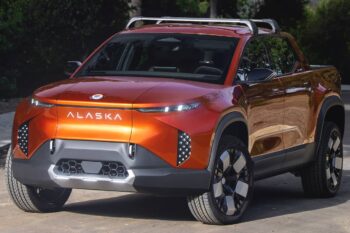Update: ‘Design,’ ‘Interior,’ ‘Specifications,’ ‘Production,’ and ‘Price & Release Date’ sections updated.
The Fisker Pear, announced as a budget electric car project in 2021 has officially become the brand’s second product, following the Fisker Ocean SUV, the deliveries of which are underway in Europe and the U.S. Reservations for the Fisker Pear are open in the United States. Early birds can pre-order with a small deposit of USD 250. Customers making a second reservation get a USD 150 discount (second reservation deposit: USD 100).
The word PEAR is an abbreviation of Personal Electric Automotive Revolution. Inspiration for the Fisker Pear “has come from some unconventional sources.” Here’s what we know about the upcoming affordable electric car:
Design
The Fisker Pear is a pure electric compact SUV featuring an off-beat design. Given the high popularity of crossover/SUV models in the brand’s core markets (existing and planned), it is understandable that it would prefer traits of this body type in the product.
Front
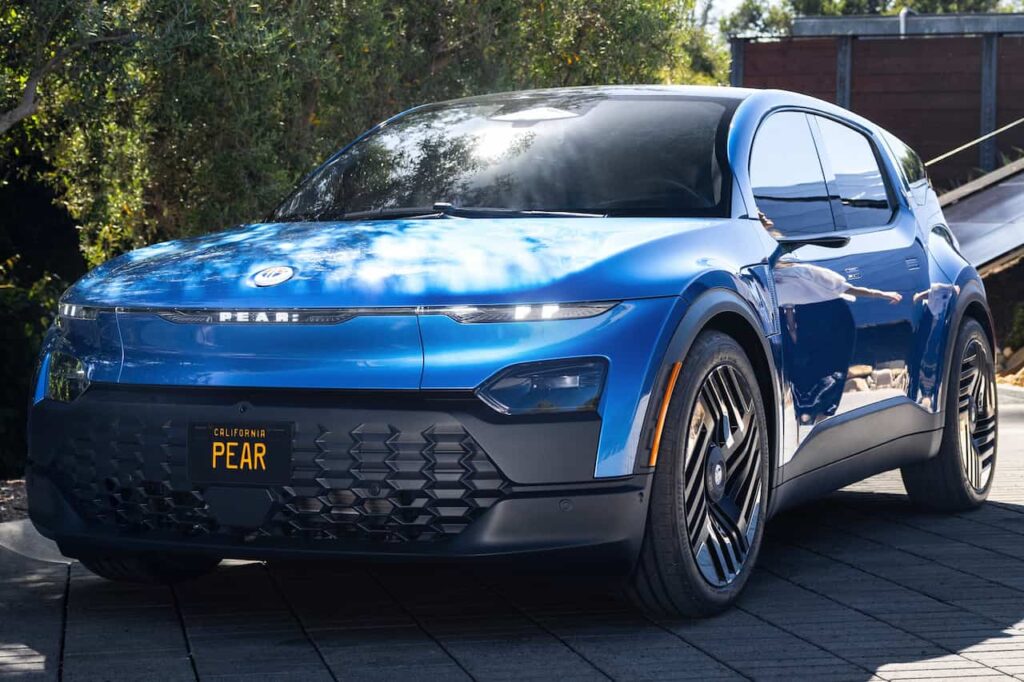
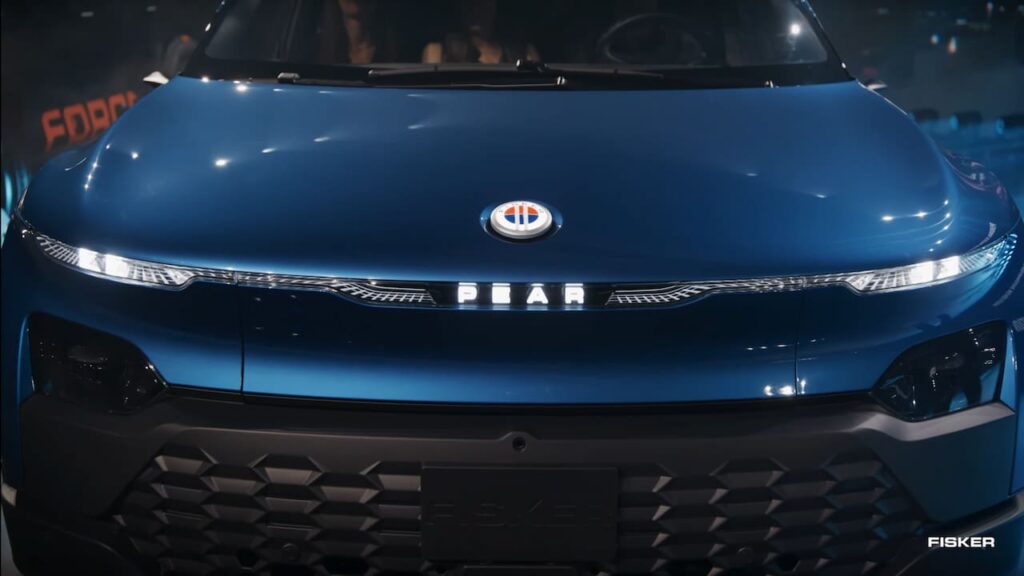
Measuring 4,550 mm (179.1 in.) in length, the Fisker Pear isn’t an urban car like the Fiat 500e or Renault Zoe. Even though it is smaller than the Ocean, it looks more aggressive. For an intense first impression, slim DRLs tuck under the hood’s shut line, flanking an illuminated Pear logo. Pentagon-shaped low- and main-beam lights have been mounted separately. The lower area has a huge grille with honeycomb inserts, probably for auto-shutoff, to improve aero.
Side
The Fisker Pear has an unusual shape, but in generic terms, one could call it a crossover. As opposed to the Ocean, which has a squarish and edgy exterior, the Pear has a rounded and curvy appearance. 20-inch wheels wrapped in low rolling resistance tires for maximum range are standard and 22-inch wheels with high-performance tires are optional.
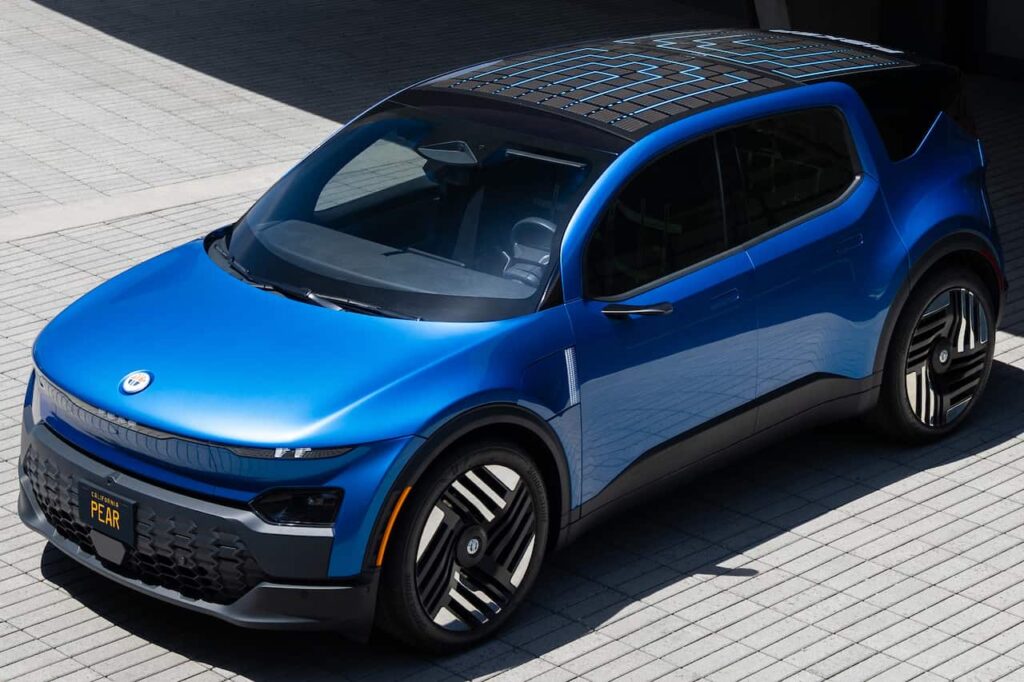
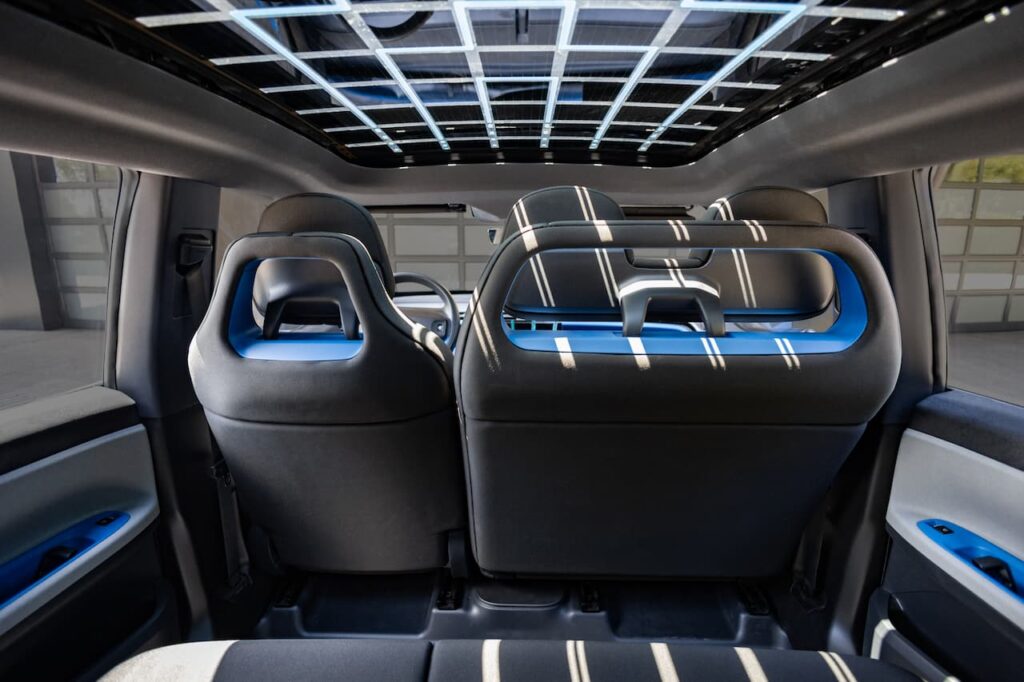
The Pear’s roofline drops quickly from the B-pillar and then meets the C-pillar to form a curve. The roofline curvature and large windows, which are certainly bigger than those of the Ocean, remind us of erstwhile French vans. Nonetheless, the Fisker Pear’s design is distinctive and is likely to appeal to a wide audience.
Also worth noting are flush-fitting door handles, circular wheel arches, and fender flares featuring marker lights/reflectors. The triangular quarter glass panel sits flush with the body, adding to the sleek styling. There are two charge port doors, both with a vertical illuminated charging level indicator, each located above and slightly behind the front wheel well.
Rear
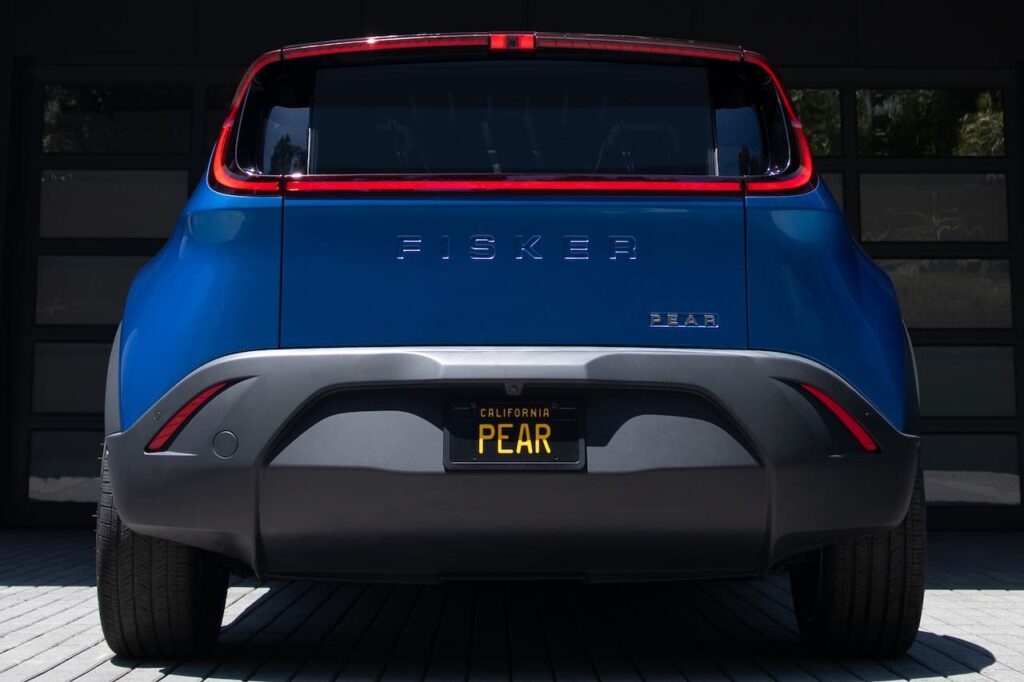
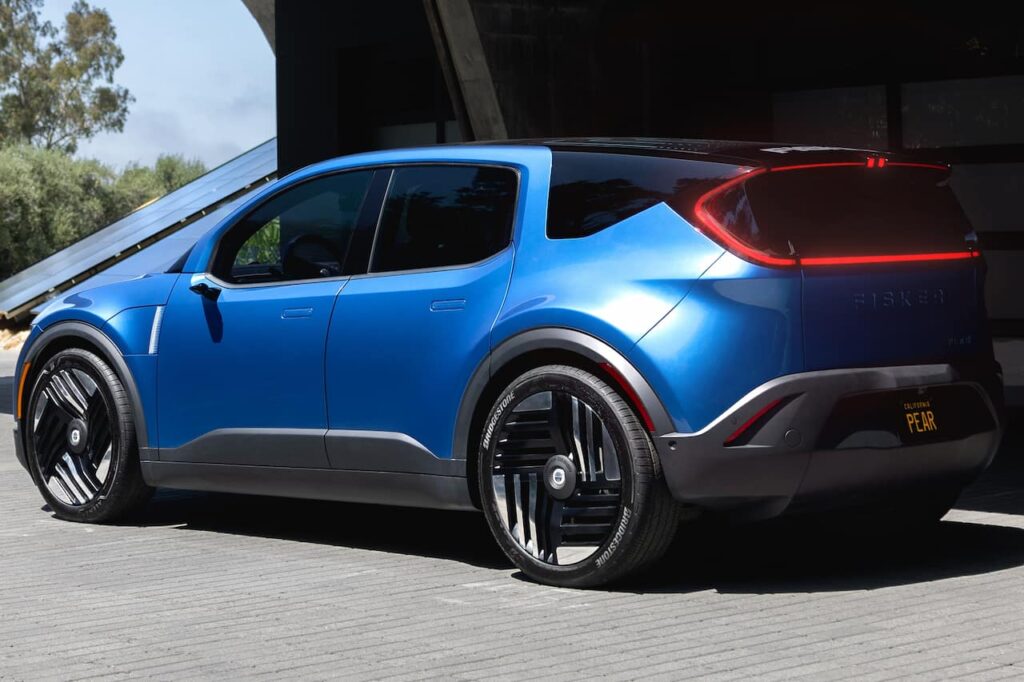
With an upright and tall rear end, the Fisker Pear should provide a lot of cargo volume behind the seats, and the driver will have good visibility while backing up. By encircling the glass area with tail lights, the EV gets a sci-fi look and the car should be easily visible from behind. The lower section looks swoopy and, like at the front, has a durable black bumper. Note how the overhangs are tight, which is to maximize space.
‘Froot’ and Houdini Trunk
One the most attractive features of the Pear is the ‘Houdini Trunk.’ When parked in a garage or a building with a low ceiling height, the trunk can be accessed without opening the liftgate. The trunk lid and glass roll down behind the rear bumper beam when the customer wants to access the cargo area behind the rear seats.
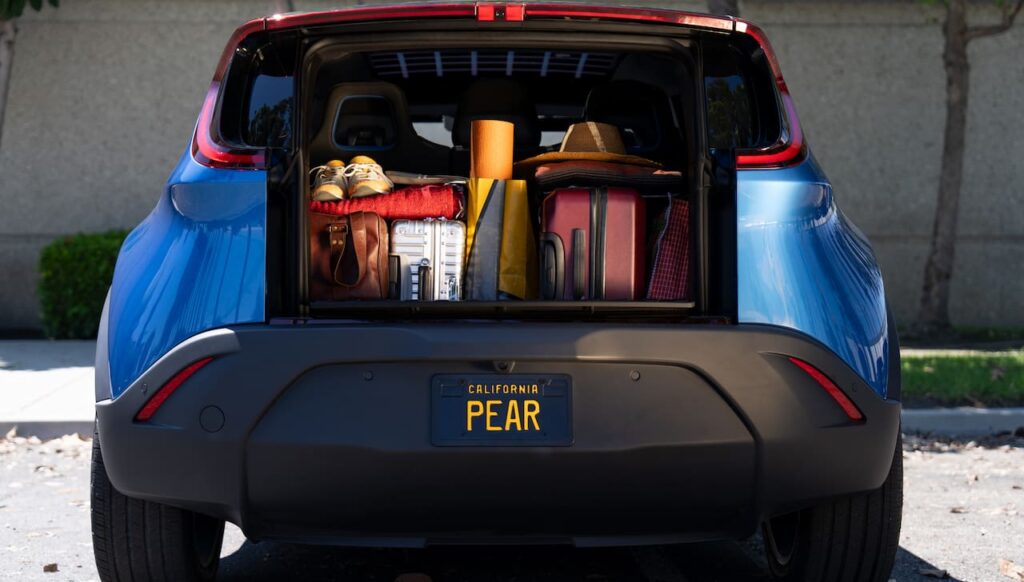
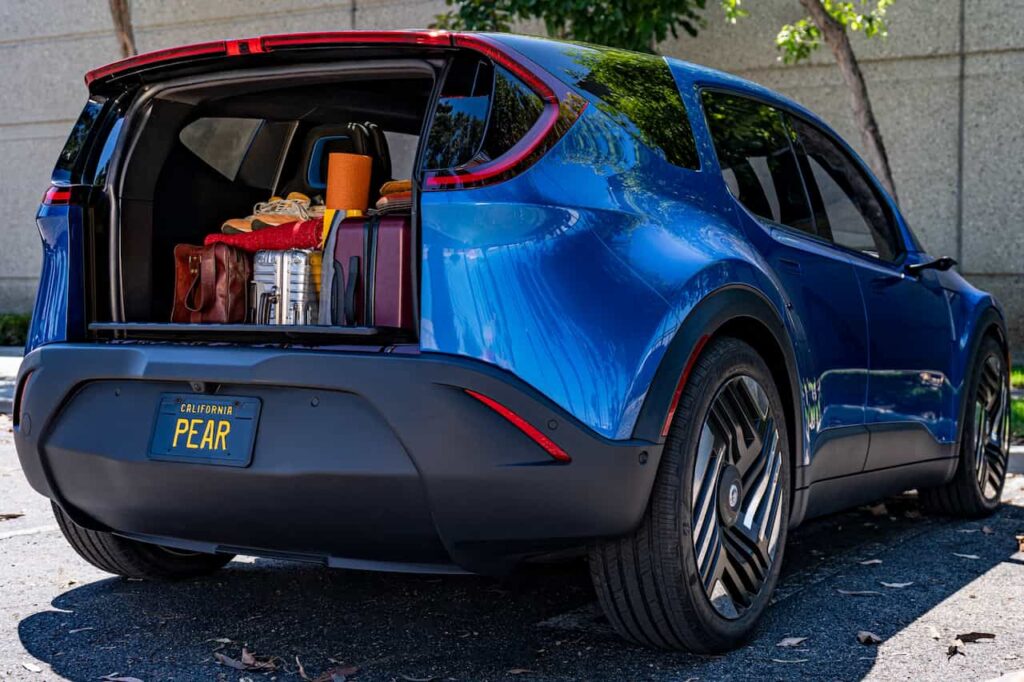
The Pear has a trunk in the front, as well, and Fisker calls that area “Froot,” a term coined as a combination of the words front and boot. Customers can store things like food items, sweaty workout gear, and small plants and avoid unwanted odors making into the cabin. Fisker will offer an insulated version of the front trunk as an option, allowing customers to keep their beverages and food at the optimal temperature.
Interior
The Fisker Pear doesn’t look fancy or elegant on the inside, and it wouldn’t be an overstatement to say it has utilitarian vibes. Fisker suggests all that’s on purpose, saying it designed the Pear to be extremely durable and avoided using fragile moving parts. In The Verge interview published on January 4, 2023, Henrik Fisker said that the company used a simplistic design approach for the interior to keep costs low.
The Pear is a two-row vehicle available in 5- and 6-seat versions. The former has two individual front seats and a big center console, while the latter comes with a combination of an individual seat for the driver and a bench seat for the passengers in the first row, without a center console. Fisker only showcased the 6-seat version at the world debut.
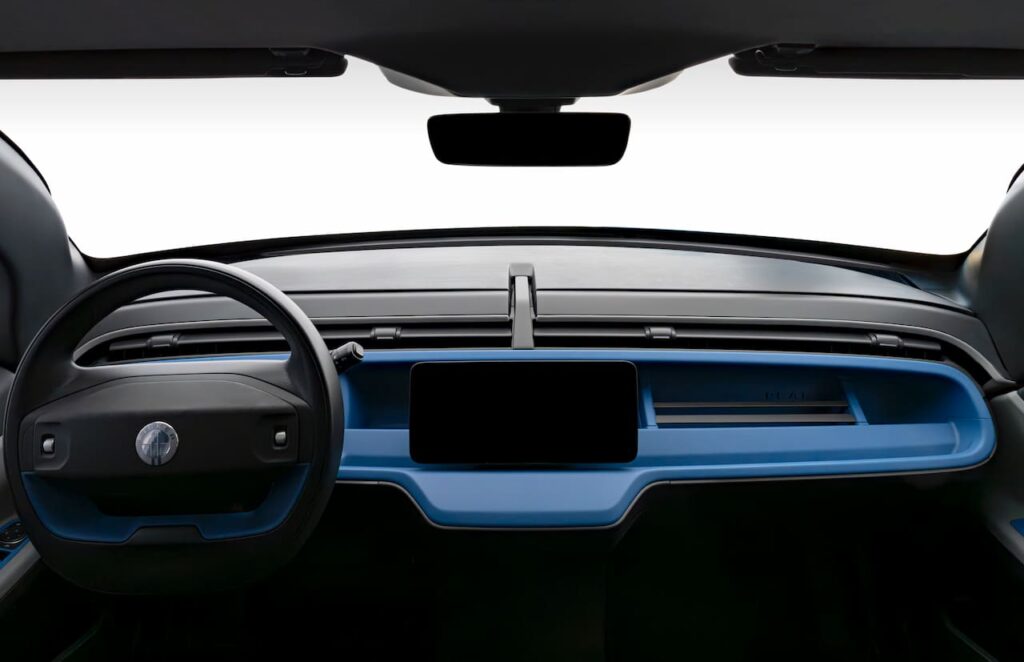
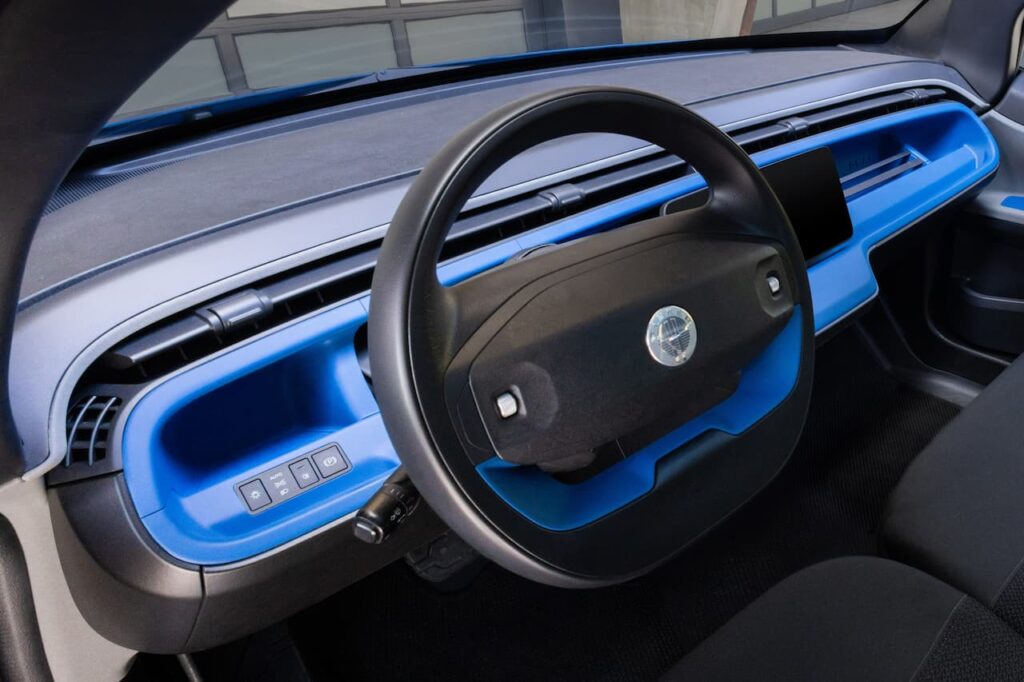
There are a lot of new types of storage places in the cabin. Everything in the dashboard is about storage. For example, there are two rubber bands on the passenger side, where customers can fasten things. The dashboard AC vents are extra-wide and sit at the top of the dashboard. The steering wheel is a two-spoke unit with a flattened bottom and a chunky center pad.
A 17.1-inch freestanding touchscreen infotainment system lies in the center of the Pear’s dashboard. Fisker has equipped the EV with a Lounge mode to let customers enjoy a movie or take a rest in it. Customers can fold all the seats flat and rotate the central display to watch a movie, something they’ll truly enjoy during a camping trip.
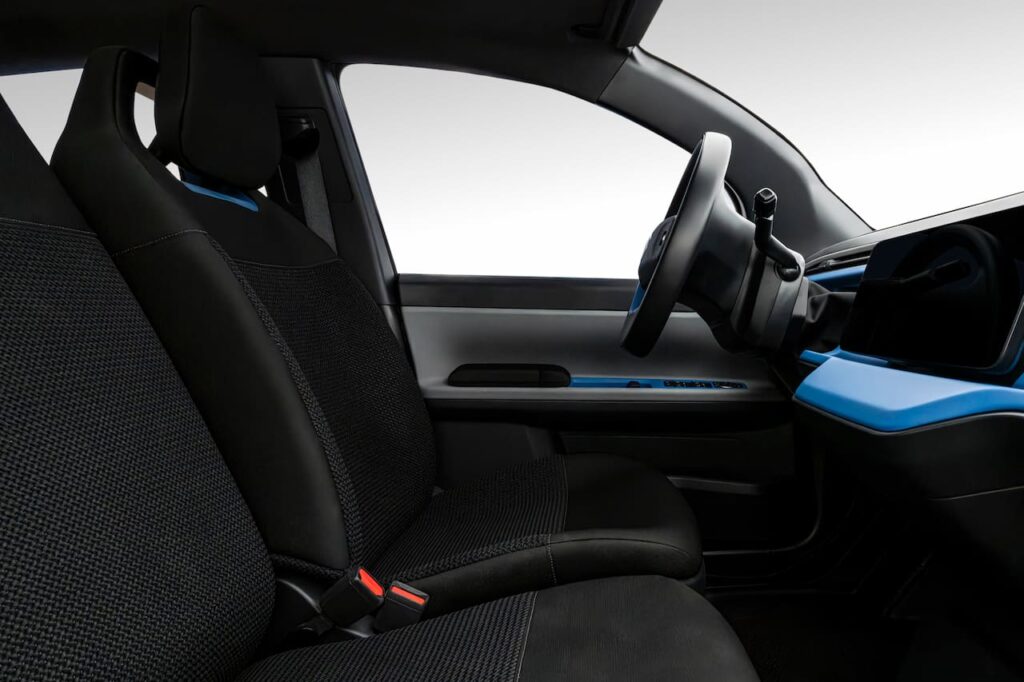
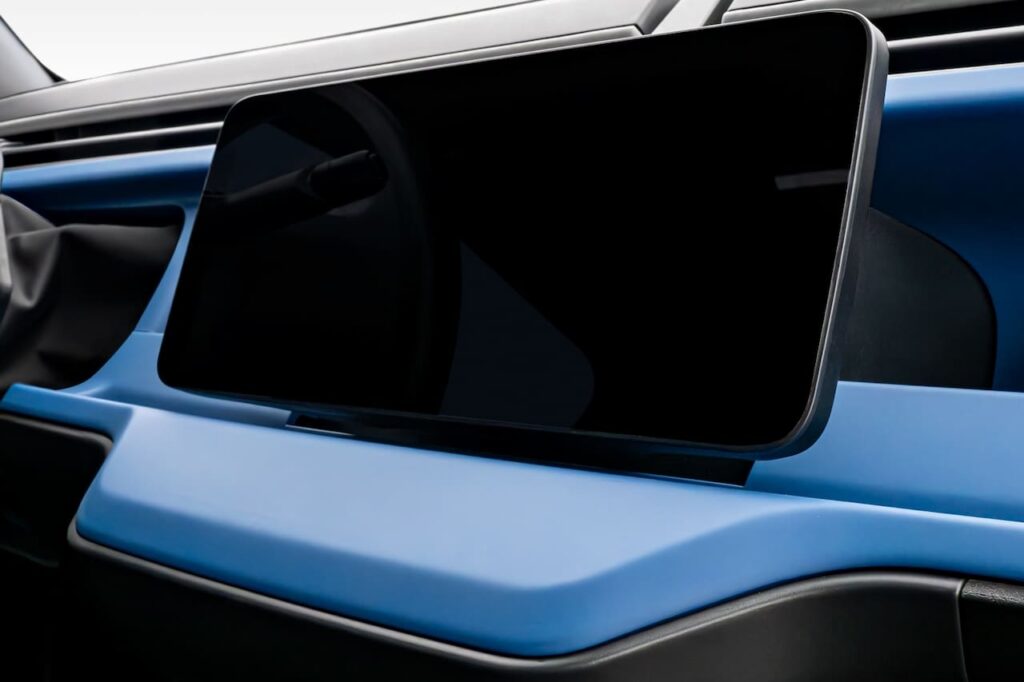
The cabin has a dark color scheme, with black as the primary color and blue for contrast, seen on the dashboard, door panels, and steering wheel. A gray color is also applied to the door panels. A large panoramic roof doubles as a solar roof that extends the driving range. Fisker has used recycled and bio-based materials in the Pear, but it’s yet to reveal the sustainability aspect in detail.
“Reinventing the car as we know it”
In an interview with Wallpaper, Fisker said that the Pear is about “reinventing the car as we know it.” Designed for urban mobility and young people, Fisker expects the new entry-level car to generate buzz and win hearts across the globe and become an iconic model like the VW Beetle and the MINI Cooper. The odds of releasing a truly iconic, worldwide classic is perhaps one in ten thousand, but Fisker is committed to designing a car that’ll be remembered for decades.
The Pear will be a revolutionary electric vehicle that won’t fit into any existing segment. The exterior design will feature new lighting technology and a wraparound front windscreen inspired by a glider plane glass canopy, enhancing frontal vision.
Henrik Fisker, President, Chairman and CEO, Fisker (on May 12, 2022)
Fisker had revealed (during the Q1 2022 earnings conference call) that the Pear will boast the company’s next-gen connectivity, ADAS functionality, and OTA platform capabilities. A “discontented” and “lower cost” version is under consideration for emerging markets.
This vehicle is so different in how it looks, how it’s going to function, some of the features, some of the way you store things in this vehicle has never been seen before. And that’s not something we want to give away to the competition anytime soon quite frankly.
Henrik Fisker, President, Chairman and CEO, Fisker (Q4 2021 and CY 2021 earnings call on February 16, 2022)
Safety
Despite its low-cost nature, the Fisker Pear won’t compromise on safety. During Fisker’s Q1 2023 earnings conference call, CTO Burkhard J. Huhnke said that the Pear’s body structure will fulfill the 25 highest global safety standards, including U.S. NCAP, European NCAP, Chinese NCAP, and IIHS Top Safety Pick. It will be competitive in NVH, durability, and functionality, he added.
Unlike Tesla, Fisker isn’t interested in Giga castings, at least not in the Pear. The CEO touched on this subject while talking about the Pear’s development during the Q1 2023 earnings conference call:
I know everybody is talking about Giga castings, but nobody talks about how much they cost. And what’s going to happen when you crash a car with such a casting? So obviously, if it’s an affordable car, you also want to be able to insure it affordably and you want to be able to repair it.
Henrik Fisker, President, Chairman and CEO, Fisker (Q4 2021 and CY 2021 earnings call on February 16, 2022)
Specifications
Platform & cost-cutting
On March 30, 2021, Fisker talked about the Pear at the Bank of America 2021 Virtual Global Automotive Summit. He indicated that the EV resulting from this project would be like no other car in the market today, ICE or electric.
The way you pay for that (urban) mobility is going to be different with this vehicle. Even the way you order options of this vehicle is going to be different. Even the way you load this vehicle is gonna be different. Everything about this vehicle will be different! Even the size of this vehicle – there is no vehicle on the planet that has the same width, length, and height.
Henrik Fisker, President, Chairman & CEO, Fisker (at Bank of America 2021 Virtual Global Automotive Summit)
SLV-1, a new platform developed in-house, will underpin the Fisker Pear, the CEO revealed during the company’s Q2 2022 earnings conference call. “SLV” in the name of the platform stands for “Symbol Versatile and Volume, while “1” probably is a reference to the fact that it’s the first model based on this platform. Later, SLV will spawn two additional models.
SLV-1 started as a Steel++ concept, where Fisker wanted to take parts out of the car. The company ended up reducing the parts count by 35% (compared to other EVs in class), and this also makes it easier to manufacture the vehicle.
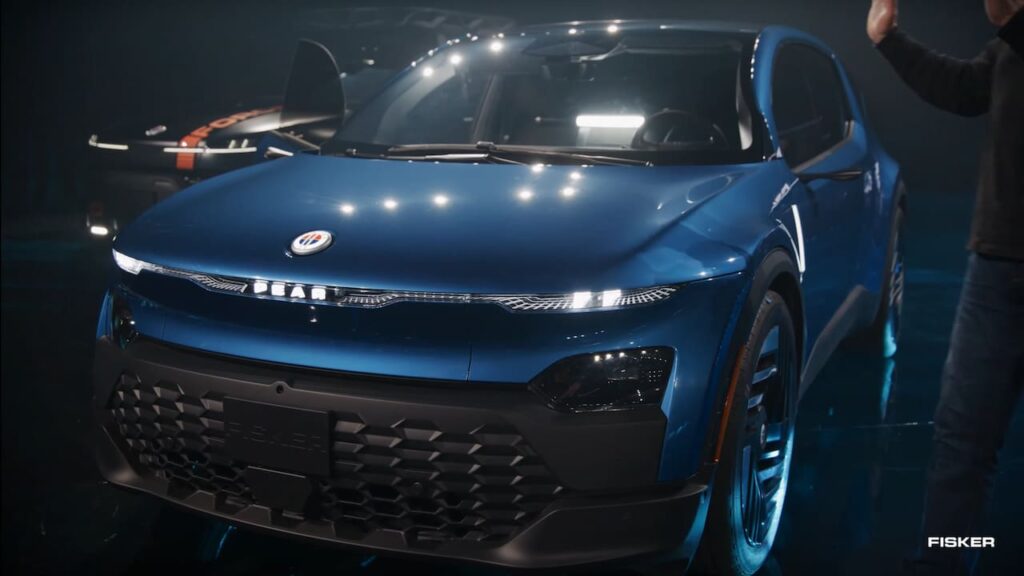
To keep production costs low, Fisker went with traditional steel for the Pear’s platform and body shell. While it’s heavier than aluminum, steel is easier and less expensive to repair if damaged, Fisker told The Verge.
During Fisker’s Q1 2022 earnings conference call on May 4, 2022, the company’s CEO said that the new platform would be very cost-efficient. The three models built on it, the other two of which come out successively in 2025 and 2026, will give the company an annual sales volume of a million units in 2027. The CEO revealed to The Verge that there was keen interest from other manufacturers to share the Pear’s (and Ocean’s) platform.
It (the new platform) will be fairly low cost — I should say really low cost to manufacture, we are able to take a lot of parts complexity out of the platform, concentrate on spending money on high technology, and really interesting consumer features that’s never been seen before.
Henrik Fisker, President, Chairman & CEO, Fisker (Q1 2022 earnings conference call on May 4, 2022)
Fisker Blade
Fisker uses an E/E (electrical/electronics) architecture with just a few central computer units internally called the ‘Fisker Blade’ in the Pear. The company is developing the Pear such that it needs fewer chips than other EVs, Fierce Electronics reported on January 14, 2022, after an interview with the brand boss.
Requiring fewer chips will help Fisker lower the cost of production and make the production schedule less vulnerable to chip shortage. Moreover, rolling out over-the-air (OTA) software updates will be simpler. The company must ensure it “optimizes” the second EV and gives customers “bang for the buck,” Neil Banerjee, VP – Advanced EE & ADAS, said.
Packaged in a slim, modular, and fully upgradable unit, the Fisker Blade delivers up to 6.2 TFLOPs and up to 25% more performance per watt consumed. An asymmetric processing architecture makes it more energy efficient. A multi-gigabit internal Ethernet network connects the rest of the vehicle systems to the Fisker Blade for high-speed networking and diagnostics. The Pear has a 5G/Wi-Fi6 wireless network, which turns it into a cloud-connected mini data center.
Performance
Fisker plans to offer the Pear in RWD and AWD variants, and it’s safe to assume that the AWD configurations will use two motors. The company is estimating a base 0-60 mph acceleration time of 6.3 seconds and a 0-100 km/h (0-62 mph) acceleration time of 6.8 seconds. It has confirmed that a high-performance ‘Pear Extreme’ is also in the pipeline.
Range
Fisker plans to offer two battery pack options for the Pear, a basic unit that delivers a range of 180 miles, and a more advanced unit that allows traveling 320 miles. These numbers are Fisker estimates and the EPA-estimated figures will likely be a bit different.
In an interview with Fiskerati in August 2022 (watch on YouTube), Fisker suggested that most customers of the Pear may not need a long range. These owners may already have a larger vehicle like the Ocean and could buy the Pear for city use. He also said that “super-fast-charging” will be available in the urban electric car.
Battery supplier
Fisker is yet to finalize its battery supplier, the CEO said during the company’s Q2 2022 earnings conference call. The company hasn’t ruled out having more than one supplier to secure its business from unanticipated risks. The company wants to source locally manufactured batteries and is considering a joint venture for the same, Fisker indicated during the call.
Variants for commercial applications
In The Verge interview cited earlier, Fisker said that the company is looking beyond sales to just private buyers. Instead, the Pear is to be compatible for value-added services such as car-sharing, ride-hailing, and even food delivery, the CEO told the American publication.
Production
To achieve the low targeted prices, Fisker is outsourcing the production to Foxconn, which will make the car in Ohio, USA. Foxconn (Hon Hai Precision Industry Co. Ltd.) is a Taiwanese contract manufacturer that manufactures Apple products. Fisker and its contract manufacturer expect to produce no less than 250,000 units of the model a year after a ramp-up period. Production of the Pear will commence in July 2025.
Price & Release date
The Fisker Pear begins at USD 29,900, or USD 22,400 if you avail of the maximum USD 7,500 federal tax credit. Deliveries will start in July 2025.
TopElectricSUV says
While Tesla’s budget electric car project has seen a delay, Fisker has set out to create a clean mobility revolution with the Pear. With a funky shape, a space-focused interior, rapid charging, and a range of 300+ miles, the Fisker Pear, at least on paper, is a promising urban EV. If production progresses smoothly, the vehicle can put Fisker on the map with its de-contented version and anticipated global sales.
Fisker Pear FAQs
What is the Fisker Pear release date?
Fisker Pear production in the U.S. will start in July 2025.
What will be the Fisker Pear price?
Fisker is targeting a $29,900 base price for the Pear. It has confirmed two range options.
Which are the main Fisker Pear rivals?
The ‘Tesla Model 2‘ and the next-gen Chevy Bolt would be the main contenders.
Featured Image Source: Fisker
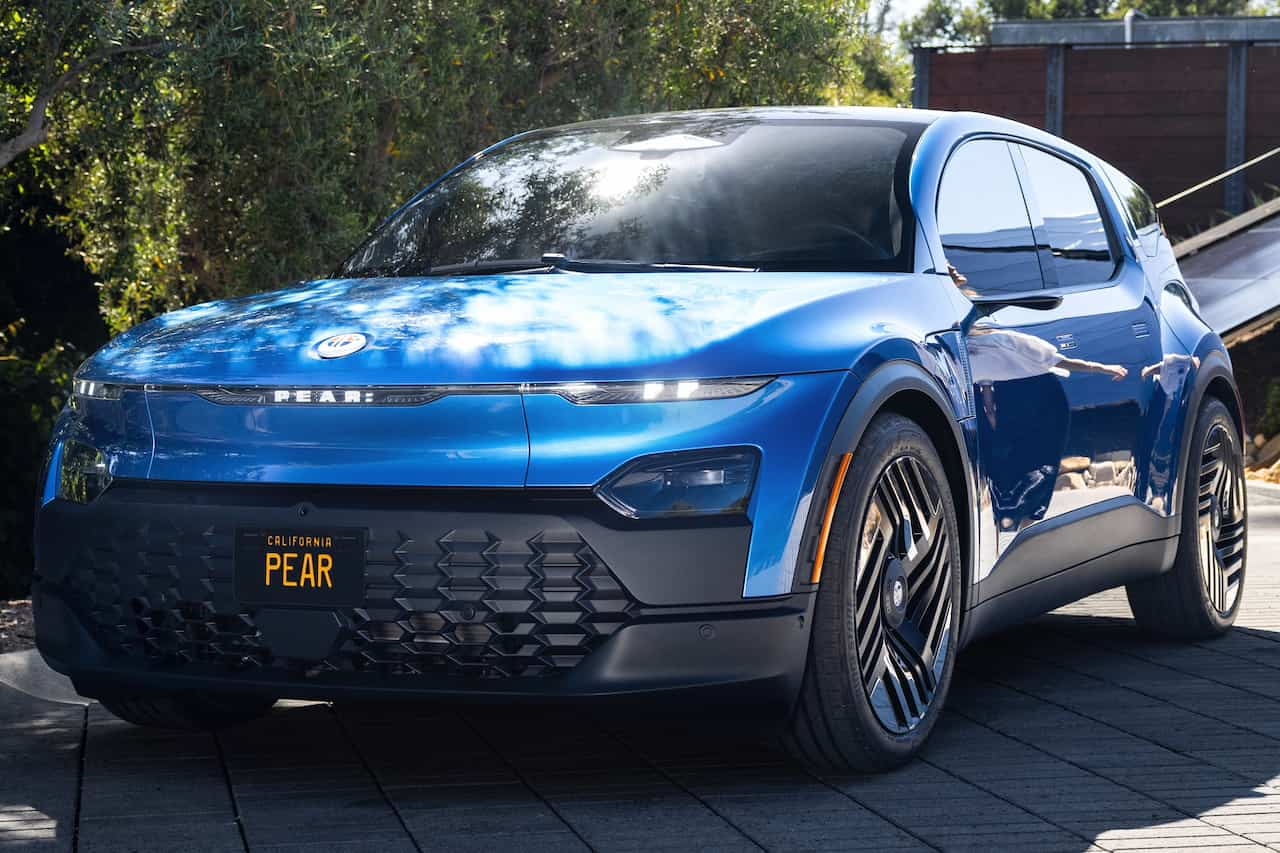

![Fisker Ocean production on track; deliveries to begin shortly [Update]](https://topelectricsuv.com/wp-content/uploads/2022/02/Fisker-Ocean-front-three-quarters-350x211.jpg)
![Fisker Ocean Force E aims to make off-roading sustainable; arriving in Q1 2024 [Update]](https://topelectricsuv.com/wp-content/uploads/2023/08/Fisker-Ocean-Force-E-lights-official-image-350x233.jpg)
